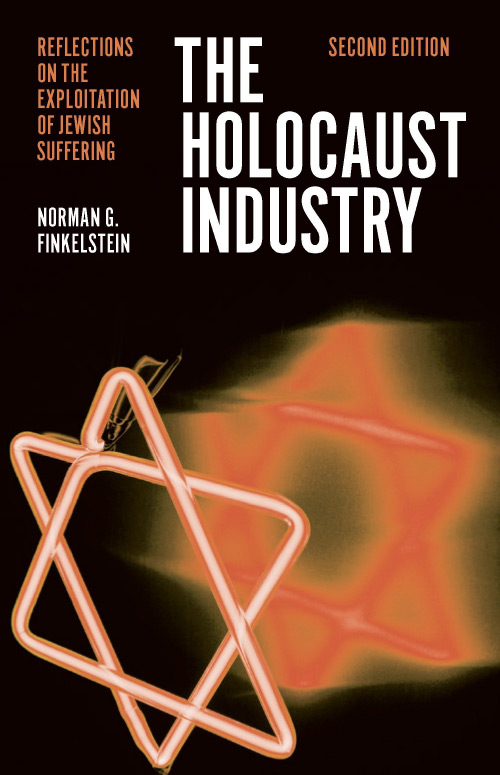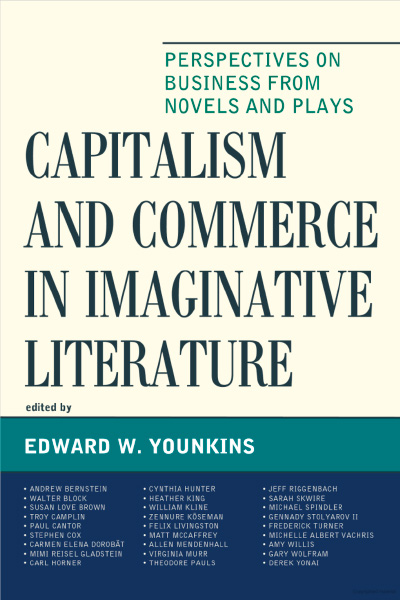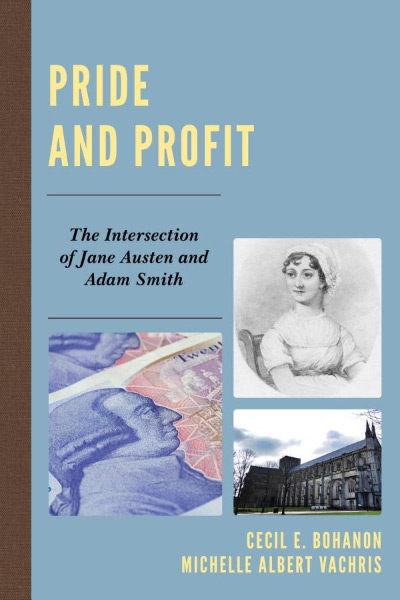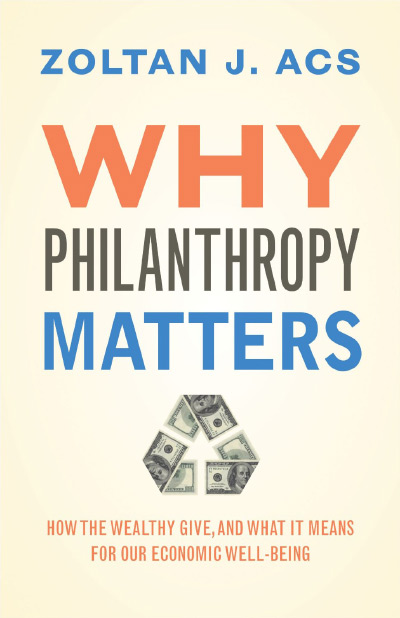The suffering of European Jews during the 1930s and 1940s gave rise to a stock of moral capital that was a measure not of exceptional moral actions by Jews as a group, but of acts committed by their Nazi oppressors. The holocaust label evokes that suffering and those acts. The Holocaust, distinguished by initial capitalization (a distinction I maintain throughout this review), is an ideology that has grown up around these interactions. The holocaust created moral capital. A “Holocaust Industry” exploits it by making a market in the suffering of “needy holocaust survivors.”
The disadvantages of moral capital are that it is less productive than most other forms of capital and that its value depreciates quickly as memories fade and the public sense of guilt and compassion wanes. Its highest value lies in its capacity to be transformed into more enduring political (rent-seeking) capital. The transformation process requires entrepreneurship as an input and spawns an industry that produces entrepreneurial returns for its creators and patrons.
These points are the foundations of historian Norman Finkelstein’s slim volume, The Holocaust Industry: Reflections on the Exploitation of Jewish Suffering. The book complements a short list of recent works by Jewish scholars (several of which Finkelstein critiques) that reflect on the upturn of interest in books, movies, and television documentaries about the holocaust and that ask (some skeptically): “Why here, and why now?” (See, for example, Peter Novick, The Holocaust in American Life [Boston: Houghton Mifflin, 1999].) Finkelstein argues, against the grain, that this interest is “a tribute not to Jewish suffering but to Jewish aggrandizement” (p. 8). He documents economic exploitation by the Holocaust Industry, which he calls an “outright extortion racket” (p. 89). He also documents the U.S. role in facilitating the extraction of holocaust rents (which he inexactly terms “profits”). He argues that the Holocaust Industry would not exist without international bullying by the United States, which is why this country is not a target of rent extraction despite having a record on holocaust issues that is scarcely distinguishable from that of the recently extorted Swiss.
A positive economic analysis of this aspect of postwar economic behavior has yet to emerge. Not even the “revisionist” literature analyzes the public economic behavior of Zionist groups and other Jewish factions. This lacuna is puzzling. Economists have tackled other aspects of religious organization using the positive method of industrial organization and public choice (see, for example, Robert Ekelund and others, Sacred Trust: The Medieval Church as an Economic Firm [New York: Oxford University Press, 1996]). Surely the existence of Holocaust rents has not entirely escaped the notice of economic historians and theorists. It may be that the holocaust’s enhanced presence today represents nothing more than market maturation. But without a positive theory with which to examine the industry’s structure, conduct, and performance, it is impossible to know.
Finkelstein’s book will probably disappoint readers hoping for an economic analysis along the lines of that by Ekelund and others. Finkelstein uses a historical approach that is like descriptive political economy. Accordingly, he develops no positive theories whose implications can be tested against the anecdotal evidence he has amassed. The result in places is a patchwork of ad hoc explanations leading to conclusions that are not obviously superior to those he criticizes. Nevertheless, the book is provocative and brimming with recent historical detail. With a bit of luck, it will attract the interest of academic economists.
The gravamen of Finkelstein’s argument, which is shared by an increasing number of Jews and others worldwide, is that “the current campaign of the Holocaust Industry to extort money from Europe in the name of ‘needy Holocaust victims’ has shrunk the moral status of martyrdom to that of a Monte Carlo casino” (p. 8). Although such blasphemy would normally be attacked as an anti-Semitic diatribe, Finkelstein escapes such treatment as the son of Jewish Auschwitz survivors. Even so, he reports being called a “garbage man,” an “anti-Zionist,” and a “notorious ideological opponent of the State of Israel” (pp. 65–66) at various times in his scholarly career. Critics disparage his book, however, by associating it with those allegedly anti-Semitic officials and private individuals who express agreement with the author’s brief. These sympathizers include, among others, citizens of western European countries who see themselves as being extorted by the Holocaust Industry, even as the Palestinian victims of Zionism remain uncompensated for their continuing loss of life, land, and liberty after decades of subjugation and subordination. Occasional proposals to compensate Palestinians out of Holocaust Industry rents wither quickly and die quietly. (Palestinians simply lack the entrepreneurial skills to press their claims successfully.) The author reports the fear in some quarters that Holocaust Industry activities will provoke a dangerous wave of bona fide anti-Semitism.
Finkelstein notes that the threat of indiscriminate, ad hominem slanders for alleged anti-Semitism has long been an effective deterrent to the public discussion of Holocaust Industry issues, which may help to explain the lack of a robust economic literature in this area. A few countries (Canada, France, and Germany, for example) have adopted laws that limit or otherwise chill public discussion. Several U.S. states presently require “approved” holocaust studies in public schools. The value of these public policies, from the industry’s perspective, lies in preventing uninhibited discussions that would dissipate Holocaust rents. Holocaust Affairs offices within the White House and the Departments of Justice and State, staunch political support in Congress, and U.S. support at the United Nations are further indicia of successful rent seeking by the Holocaust Industry.
Viewing history through an economic lens shows how “the Holocaust” has become a proprietary trademark. The murder of between three and six million Jews (industry estimates usually exceed historical estimates) was not intrinsically unique to a century that witnessed the wholesale slaughter of many ethnic groups, including the Nazis’ systematic killing of Gypsies, homosexuals, and physically and mentally disabled individuals. The twentieth century’s body count ran into the hundreds of millions, with many victims in the latter years being killed by Israeli-made weapons. Even so, the Holocaust Industry has created a property right in the “uniqueness” of the holocaust. This right is defended aggressively. Every application of the Holocaust label to other large-scale atrocities, most recently to the systematic killing of Muslims in Kosovo, is actively opposed. (Governments that sponsor atrocities also oppose the application of this label in order to soften the public perception of their actions.) Xerox opposes the generic labeling of document reproduction as xeroxing for exactly the same reason.
The aggressive defense and maintenance of the Holocaust brand have been so successful that even a few gentiles have gained wealth and notoriety by masquerading as Jewish holocaust survivors—an ironic example of chutzpah. Watchdog groups are alert for outsiders’ poaching Holocaust rents in this fashion. Some Jews also capture Holocaust rents by masquerading as holocaust survivors, usually winning industry praise rather than condemnation for their efforts.
Finkelstein singles out Elie Wiesel, a concentration-camp survivor and celebrity commentator on moral issues, for his role as an industry insider. He “is the Holocaust” (p. 55), according to Finkelstein. It was Wiesel who systematically applied the word holocaust to the Jewish experience. He subsequently gained recognition and fortune by lecturing about the holocaust, commanding speaking fees that Finkelstein reports to be upward of $25,000 plus a limousine. Finkelstein criticizes the fuzzy aphorisms Wiesel uses to characterize the holocaust—“noncommunicable,” “we cannot talk about it,” and “the truth lies in silence”—noting that Wiesel and others have made personal fortunes by talking and writing about it (p. 45).
The lack of a positive theory to explain industry behavior causes Finkelstein’s analysis occasionally to go astray. He dates the Holocaust Industry from the 1967 Arab-Israeli War. That date clearly represents an important point in the industry’s development, as he demonstrates, but it represents a point of inflection rather than a true beginning. The industry’s creation, in the most encompassing sense, occurred more than twenty years earlier. Holocaust entrepreneurship and rent seeking played the determining role in creating the modern state of Israel, a series of events that Finkelstein dismisses as unrelated to the industry per se. By contrast, these events were comprehensively documented early on by the historian Alfred Lilienthal, whose work anticipated the logic of public-choice analysis (see, for example, What Price Israel? [Chicago: Henry Regnery, 1953]). Lilienthal, almost uniquely among Jews of that period, wrote and spoke against the creation of Israel, opposed charitable U.S. policies toward it, and coined the term Holocaustomania to characterize the use of Holocaust rhetoric to stifle public debate. He documented the opportunistic postwar actions of entrepreneurial Zionist organizers who manipulated, for essentially private purposes, both the postwar sensitivities of national governments and the anguish and misery of Jewish concentration-camp survivors. Lilienthal’s scholarly efforts were rewarded with anonymous death threats and several years of FBI surveillance.
Finkelstein’s presentation implies that Zionist goals no longer motivate the exploitation of holocaust survivors. He argues directly that today’s Holocaust Industry is not truly concerned with obtaining compensation for “needy holocaust survivors,” noting that very little of the recently extracted “compensation” has reached its nominal beneficiaries. Instead, the industry’s concern today lies with winning compensation for law firms, consultants, politicians, Holocaust organizations, and industry elites. “When Jewish elites rob Jewish survivors no ethical issues arise; it’s just about the money” (p. 87).
Finkelstein’s focus on 1967 as the creation date of the industry causes him to overlook the competition for the Jewish vote that characterized the 1948 Truman-Dewey presidential campaign and other elections for state and national offices (see, for example, John Snetsinger, Truman, the Jewish Vote, and the Creation of Israel [Stanford, Calif.: Hoover Institution Press, 1974]). Incumbents and challengers competed wildly to outdo each other’s campaign promises in support of Zionism. Politicians at all levels accepted speaking fees from Zionist and other Jewish groups. Truman summarized his developing position in 1946 by telling a gathering of diplomats: “I have to answer to hundreds of thousands who are anxious for the success of Zionism; I do not have hundreds of thousands of Arabs among my constituents” (qtd. in William Eddy, FDR Meets Ibn Saud [New York: American Friends of the Middle East, 1954], p. 37). The concentration of Jewish voters in a small number of U.S. cities made the political “collective-action” problem relatively easy to overcome: Lilienthal reported census data showing that 42 percent of American Jews lived in the five boroughs of New York City, and 75 percent were concentrated in just fourteen cities.
A victorious President Truman made good on his campaign promises in several significant ways: by supporting the creation of modern Israel over the vehement objection of Secretary of State George Marshall; by supporting financial aid to Israel that (by Lilienthal’s calculation) was nearly seven times greater per capita in 1952 than the amount given to Europe under the Marshall Plan; and by authorizing, over State Department objections, U.S. fund-raising and lobbying visits by self-confessed Zionist terrorists, including at least one future Israeli prime minister, Menachem Begin.
Finkelstein’s book, by comparison, merely documents the methods by which today’s politicians support the industry while in office and then earn substantial legal and consulting fees by representing its interests when out of office.
The weakness of Finkelstein’s descriptive historical approach is most apparent in his explanation of the U.S. decision to authorize construction and federal funding of a Holocaust memorial and museum on the National Mall in Washington, D.C. The National Mall is a hallowed piece of ground otherwise reserved for commemorating episodes in U.S. history. Finkelstein asserts that the memorial’s ulterior purpose is to demonstrate that a holocaust could not occur in the United States, thereby camouflaging the country’s actual treatment of its imported African and native populations. This explanation may have a satisfying feel to it, but it lacks a positive foundation and almost certainly is off the mark. A positive theory in this context would examine the memorial’s presence in terms of its value to the Holocaust Industry, the process and effect of lobbying by powerful factions, and the political calculations made by Congress and the Carter White House. Finkelstein documents each of these considerations, but his conclusion ignores their significance.
The author clearly is sensitive to the economic aspects of his subject, even though he does not develop his thesis along positive lines. However, by documenting the legacy of systematic exploitation, extortion, and de jure political correctness with regard to the holocaust, he opens the door to positive analysis of this unique but culturally and politically sensitive aspect of postwar economic behavior. In addition to the book’s virtues as a provocative and well-documented case study, this achievement makes The Holocaust Industry both a worthwhile read and a valuable reference.
| Other Independent Review articles by James A. Montanye | ||
| Summer 2018 | Digital Revolutions in Public Finance | |
| Winter 2015/16 | Does Altruism Exist?: Culture, Genes, and the Welfare of Others | |
| Fall 2014 | The Great Debate: Edmund Burke, Thomas Paine, and the Birth of Right and Left | |
| [View All (24)] | ||


















